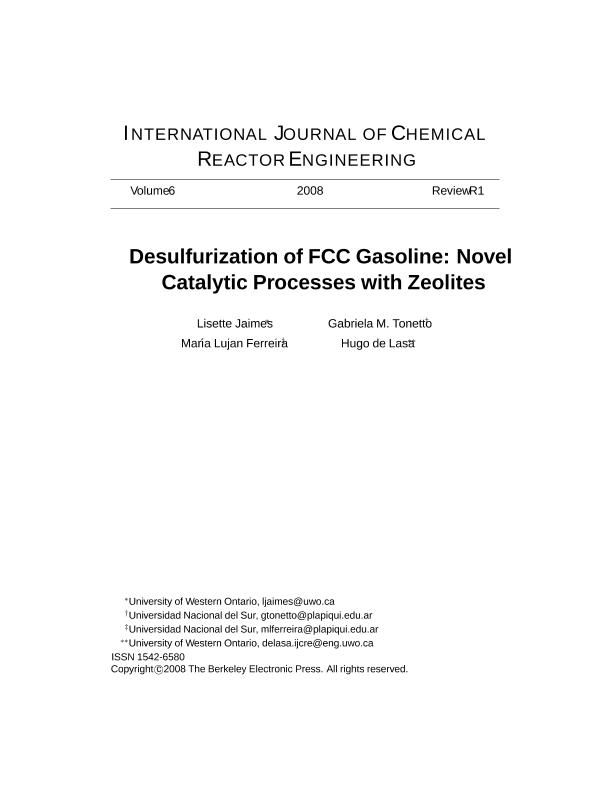Artículo
Desulfurization of FCC Gasoline: Novel Catalytic Processes with Zeolites
Fecha de publicación:
01/2008
Editorial:
Berkeley Electronic Press
Revista:
International Journal of Chemical Reactor Engineering
ISSN:
1542-6580
Idioma:
Inglés
Tipo de recurso:
Artículo publicado
Clasificación temática:
Resumen
New regulations aim to achieve a drastic sulfur emission reduction in fuels and impose very low sulfur concentration caps (30 ppm in gasoline and 15 ppm in diesel) that will be in full force in 2009. FCC gasoline represents almost 40% of the total gasoline pool and it is the major sulfur contributor, with up to 85– 95%. To deal with this situation, most refiners have adopted post-treating FCC gasoline processes given they are more viable and less costly for meeting sulfur environmental regulation limits. In this respect, one should notice that conventional hydro-treating of FCC gasoline removes sulfur decreasing gasoline quality with octane number losses. The use of hydrogen also adds important costs to the desulfurization. As a result, new promising catalytic desulfurization processes are being proposed using zeolites as adsorbents/catalysts. These new approaches may lead to novel technologies, for example, with the case of gasoline de-hydrosulfidation with no hydrogen addition and alternatively to adsorption processes with co-feeding of an H-donor being pioneered at CREC University of Western Ontario. In both approaches sulfur is efficiently removed leaving the gasoline octane number index intact. The zeolite structure, the framework composition and the properties of the charge compensating cations are all parameters with major impact on catalytic desulfurization. In particular, shape selectivity is expected to play an important role in determining product selectivity when condensation reactions are significant. In this respect, the H-ZSM5 zeolite appears to have the adequate balance of Bronsted acidity and Lewis basicity to efficiently ¨ convert thiophene to H2S, with minimal transformation of benzothiophene and oligomers into coke. From a chemical reactor engineering point of view, novel gasoline desulfurization can be implemented using both fixed and fluidized bed reactors. Fluidized circulating bed reactors display high sulfur removal ability allowing frequent catalyst removal from the catalytic bed and coke combustion in a twin fluidized regeneration unit. Fixed bed units with adsorption/desorption cycles, used in conjunction with and without H donor co-reactants, lead to selective adsorption and efficient removal of sulfur species.
Palabras clave:
Desulfurization
,
Catalytic
,
Process
,
Gasoline
,
Zeolites
,
Mechanisms
,
Thermodynamic
,
Kinetics
Archivos asociados
Licencia
Identificadores
Colecciones
Articulos(PLAPIQUI)
Articulos de PLANTA PILOTO DE INGENIERIA QUIMICA (I)
Articulos de PLANTA PILOTO DE INGENIERIA QUIMICA (I)
Citación
Lisette, Jaimes; Tonetto, Gabriela Marta; Ferreira, María Luján; de Lasa, Hugo; Desulfurization of FCC Gasoline: Novel Catalytic Processes with Zeolites; Berkeley Electronic Press; International Journal of Chemical Reactor Engineering; 6; 1; 1-2008; 1-69
Compartir
Altmétricas




